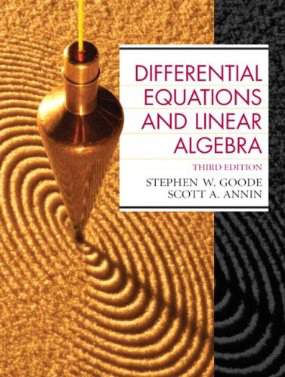

Professor Murray
Distinct Real Eigenvalues
Slide Duration:Table of Contents
Section 1: First-Order Equations
Linear Equations
1h 7m 21s
- Intro0:00
- Lesson Objectives0:19
- How to Solve Linear Equations2:54
- Calculate the Integrating Factor2:58
- Changes the Left Side so We Can Integrate Both Sides3:27
- Solving Linear Equations5:32
- Further Notes6:10
- If P(x) is Negative6:26
- Leave Off the Constant9:38
- The C Is Important When Integrating Both Sides of the Equation9:55
- Example 110:29
- Example 222:56
- Example 336:12
- Example 439:24
- Example 544:10
- Example 656:42
Separable Equations
35m 11s
- Intro0:00
- Lesson Objectives0:19
- Some Equations Are Both Linear and Separable So You Can Use Either Technique to Solve Them1:33
- Important to Add C When You Do the Integration2:27
- Example 14:28
- Example 210:45
- Example 314:43
- Example 419:21
- Example 527:23
Slope & Direction Fields
1h 11m 36s
- Intro0:00
- Lesson Objectives0:20
- If You Can Manipulate a Differential Equation Into a Certain Form, You Can Draw a Slope Field Also Known as a Direction Field0:23
- How You Do This0:45
- Solution Trajectories2:49
- Never Cross Each Other3:44
- General Solution to the Differential Equation4:03
- Use an Initial Condition to Find Which Solution Trajectory You Want4:59
- Example 16:52
- Example 214:20
- Example 326:36
- Example 434:21
- Example 546:09
- Example 659:51
Applications, Modeling, & Word Problems of First-Order Equations
1h 5m 19s
- Intro0:00
- Lesson Overview0:38
- Mixing1:00
- Population2:49
- Finance3:22
- Set Variables4:39
- Write Differential Equation6:29
- Solve It10:54
- Answer Questions11:47
- Example 113:29
- Example 224:53
- Example 332:13
- Example 442:46
- Example 555:05
Autonomous Equations & Phase Plane Analysis
1h 1m 20s
- Intro0:00
- Lesson Overview0:18
- Autonomous Differential Equations Have the Form y' = f(x)0:21
- Phase Plane Analysis0:48
- y' < 02:56
- y' > 03:04
- If we Perturb the Equilibrium Solutions5:51
- Equilibrium Solutions7:44
- Solutions Will Return to Stable Equilibria8:06
- Solutions Will Tend Away From Unstable Equilibria9:32
- Semistable Equilibria10:59
- Example 111:43
- Example 215:50
- Example 328:27
- Example 431:35
- Example 543:03
- Example 649:01
Section 2: Second-Order Equations
Distinct Roots of Second Order Equations
28m 44s
- Intro0:00
- Lesson Overview0:36
- Linear Means0:50
- Second-Order1:15
- Homogeneous1:30
- Constant Coefficient1:55
- Solve the Characteristic Equation2:33
- Roots r1 and r23:43
- To Find c1 and c2, Use Initial Conditions4:50
- Example 15:46
- Example 28:20
- Example 316:20
- Example 418:26
- Example 523:52
Complex Roots of Second Order Equations
31m 49s
- Intro0:00
- Lesson Overview0:15
- Sometimes The Characteristic Equation Has Complex Roots1:12
- Example 13:21
- Example 27:42
- Example 315:25
- Example 418:59
- Example 527:52
Repeated Roots & Reduction of Order
43m 2s
- Intro0:00
- Lesson Overview0:23
- If the Characteristic Equation Has a Double Root1:46
- Reduction of Order3:10
- Example 17:23
- Example 29:20
- Example 314:12
- Example 431:49
- Example 533:21
Undetermined Coefficients of Inhomogeneous Equations
50m 1s
- Intro0:00
- Lesson Overview0:11
- Inhomogeneous Equation Means the Right Hand Side is Not 0 Anymore0:21
- First Solve the Homogeneous Equation1:04
- Find a Particular Solution to the Inhomogeneous Equation Using Undetermined Coefficients2:03
- g(t) vs. Guess for ypar2:42
- If Any Term of Your Guess for ypar Looks Like Any Term of yhom5:07
- Example 17:54
- Example 215:25
- Example 323:45
- Example 433:35
- Example 542:57
Inhomogeneous Equations: Variation of Parameters
49m 22s
- Intro0:00
- Lesson Overview0:31
- Inhomogeneous vs. Homogeneous0:47
- First Solve the Homogeneous Equation1:17
- Notice There is No Coefficient in Front of y''1:27
- Find a Particular Solution to the Inhomogeneous Equation Using Variation of Parameters2:32
- How to Solve4:33
- Hint on Solving the System5:23
- Example 17:27
- Example 217:46
- Example 323:14
- Example 431:49
- Example 536:00
Section 3: Series Solutions
Review of Power Series
57m 38s
- Intro0:00
- Lesson Overview0:36
- Taylor Series Expansion0:37
- Maclaurin Series2:36
- Common Maclaurin Series to Remember From Calculus3:35
- Radius of Convergence7:58
- Ratio Test12:05
- Example 115:18
- Example 220:02
- Example 327:32
- Example 439:33
- Example 545:42
Series Solutions Near an Ordinary Point
1h 20m 28s
- Intro0:00
- Lesson Overview0:49
- Guess a Power Series Solution and Calculate Its Derivatives, Example 11:03
- Guess a Power Series Solution and Calculate Its Derivatives, Example 23:14
- Combine the Series5:00
- Match Exponents on x By Shifting Indices5:11
- Match Starting Indices By Pulling Out Initial Terms5:51
- Find a Recurrence Relation on the Coefficients7:09
- Example 17:46
- Example 219:10
- Example 329:57
- Example 441:46
- Example 557:23
- Example 61:09:12
Euler Equations
24m 42s
- Intro0:00
- Lesson Overview0:11
- Euler Equation0:15
- Real, Distinct Roots2:22
- Real, Repeated Roots2:37
- Complex Roots2:49
- Example 13:51
- Example 26:20
- Example 38:27
- Example 413:04
- Example 515:31
- Example 618:31
Series Solutions
1h 26m 17s
- Intro0:00
- Lesson Overview0:13
- Singular Point1:17
- Definition: Pole of Order n1:58
- Pole Of Order n2:04
- Regular Singular Point3:25
- Solving Around Regular Singular Points7:08
- Indical Equation7:30
- If the Difference Between the Roots is An Integer8:06
- If the Difference Between the Roots is Not An Integer8:29
- Example 18:47
- Example 214:57
- Example 325:40
- Example 447:23
- Example 51:09:01
Section 4: Laplace Transform
Laplace Transforms
41m 52s
- Intro0:00
- Lesson Overview0:09
- Laplace Transform of a Function f(t)0:18
- Laplace Transform is Linear1:04
- Example 11:43
- Example 218:30
- Example 322:06
- Example 428:27
- Example 533:54
Inverse Laplace Transforms
47m 5s
- Intro0:00
- Lesson Overview0:09
- Laplace Transform L{f}0:13
- Run Partial Fractions0:24
- Common Laplace Transforms1:20
- Example 13:24
- Example 29:55
- Example 314:49
- Example 422:03
- Example 533:51
Laplace Transform Initial Value Problems
45m 15s
- Intro0:00
- Lesson Overview0:12
- Start With Initial Value Problem0:14
- Take the Laplace Transform of Both Sides of the Differential Equation0:37
- Plug in the Identities1:20
- Take the Inverse Laplace Transform to Find y2:40
- Example 14:15
- Example 211:30
- Example 317:59
- Example 424:51
- Example 536:05
Section 5: Review of Linear Algebra
Review of Linear Algebra
57m 30s
- Intro0:00
- Lesson Overview0:41
- Matrix0:54
- Determinants4:45
- 3x3 Determinants5:08
- Eigenvalues and Eigenvectors7:01
- Eigenvector7:48
- Eigenvalue7:54
- Lesson Overview8:17
- Characteristic Polynomial8:47
- Find Corresponding Eigenvector9:03
- Example 110:19
- Example 216:49
- Example 320:52
- Example 425:34
- Example 535:05
Section 6: Systems of Equations
Distinct Real Eigenvalues
59m 26s
- Intro0:00
- Lesson Overview1:11
- How to Solve Systems2:48
- Find the Eigenvalues and Their Corresponding Eigenvectors2:50
- General Solution4:30
- Use Initial Conditions to Find c1 and c24:57
- Graphing the Solutions5:20
- Solution Trajectories Tend Towards 0 or ∞ Depending on Whether r1 or r2 are Positive or Negative6:35
- Solution Trajectories Tend Towards the Axis Spanned by the Eigenvector Corresponding to the Larger Eigenvalue7:27
- Example 19:05
- Example 221:06
- Example 326:38
- Example 436:40
- Example 543:26
- Example 651:33
Complex Eigenvalues
1h 3m 54s
- Intro0:00
- Lesson Overview0:47
- Recall That to Solve the System of Linear Differential Equations, We find the Eigenvalues and Eigenvectors0:52
- If the Eigenvalues are Complex, Then They Will Occur in Conjugate Pairs1:13
- Expanding Complex Solutions2:55
- Euler's Formula2:56
- Multiply This Into the Eigenvector, and Separate Into Real and Imaginary Parts1:18
- Graphing Solutions From Complex Eigenvalues5:34
- Example 19:03
- Example 220:48
- Example 328:34
- Example 441:28
- Example 551:21
Repeated Eigenvalues
45m 17s
- Intro0:00
- Lesson Overview0:44
- If the Characteristic Equation Has a Repeated Root, Then We First Find the Corresponding Eigenvector1:14
- Find the Generalized Eigenvector1:25
- Solutions from Repeated Eigenvalues2:22
- Form the Two Principal Solutions and the Two General Solution2:23
- Use Initial Conditions to Solve for c1 and c23:41
- Graphing the Solutions3:53
- Example 18:10
- Example 216:24
- Example 323:25
- Example 431:04
- Example 538:17
Section 7: Inhomogeneous Systems
Undetermined Coefficients for Inhomogeneous Systems
43m 37s
- Intro0:00
- Lesson Overview0:35
- First Solve the Corresponding Homogeneous System x'=Ax0:37
- Solving the Inhomogeneous System2:32
- Look for a Single Particular Solution xpar to the Inhomogeneous System2:36
- Plug the Guess Into the System and Solve for the Coefficients3:27
- Add the Homogeneous Solution and the Particular Solution to Get the General Solution3:52
- Example 14:49
- Example 29:30
- Example 315:54
- Example 420:39
- Example 529:43
- Example 637:41
Variation of Parameters for Inhomogeneous Systems
1h 8m 12s
- Intro0:00
- Lesson Overview0:37
- Find Two Solutions to the Homogeneous System2:04
- Look for a Single Particular Solution xpar to the inhomogeneous system as follows2:59
- Solutions by Variation of Parameters3:35
- General Solution and Matrix Inversion6:35
- General Solution6:41
- Hint for Finding Ψ-16:58
- Example 18:13
- Example 216:23
- Example 332:23
- Example 437:34
- Example 549:00
Section 8: Numerical Techniques
Euler's Method
45m 30s
- Intro0:00
- Lesson Overview0:32
- Euler's Method is a Way to Find Numerical Approximations for Initial Value Problems That We Cannot Solve Analytically0:34
- Based on Drawing Lines Along Slopes in a Direction Field1:18
- Formulas for Euler's Method1:57
- Example 14:47
- Example 214:45
- Example 324:03
- Example 433:01
- Example 537:55
Runge-Kutta & The Improved Euler Method
41m 4s
- Intro0:00
- Lesson Overview0:43
- Runge-Kutta is Know as the Improved Euler Method0:46
- More Sophisticated Than Euler's Method1:09
- It is the Fundamental Algorithm Used in Most Professional Software to Solve Differential Equations1:16
- Order 2 Runge-Kutta Algorithm1:45
- Runge-Kutta Order 2 Algorithm2:09
- Example 14:57
- Example 210:57
- Example 319:45
- Example 424:35
- Example 531:39
Section 9: Partial Differential Equations
Review of Partial Derivatives
38m 22s
- Intro0:00
- Lesson Overview1:04
- Partial Derivative of u with respect to x1:37
- Geometrically, ux Represents the Slope As You Walk in the x-direction on the Surface2:47
- Computing Partial Derivatives3:46
- Algebraically, to Find ux You Treat The Other Variable t as a Constant and Take the Derivative with Respect to x3:49
- Second Partial Derivatives4:16
- Clairaut's Theorem Says that the Two 'Mixed Partials' Are Always Equal5:21
- Example 15:34
- Example 27:40
- Example 311:17
- Example 414:23
- Example 531:55
The Heat Equation
44m 40s
- Intro0:00
- Lesson Overview0:28
- Partial Differential Equation0:33
- Most Common Ones1:17
- Boundary Value Problem1:41
- Common Partial Differential Equations3:41
- Heat Equation4:04
- Wave Equation5:44
- Laplace's Equation7:50
- Example 18:35
- Example 214:21
- Example 321:04
- Example 425:54
- Example 535:12
Separation of Variables
57m 44s
- Intro0:00
- Lesson Overview0:26
- Separation of Variables is a Technique for Solving Some Partial Differential Equations0:29
- Separation of Variables2:35
- Try to Separate the Variables2:38
- If You Can, Then Both Sides Must Be Constant2:52
- Reorganize These Intro Two Ordinary Differential Equations3:05
- Example 14:41
- Example 211:06
- Example 318:30
- Example 425:49
- Example 532:53
Fourier Series
1h 24m 33s
- Intro0:00
- Lesson Overview0:38
- Fourier Series0:42
- Find the Fourier Coefficients by the Formulas2:05
- Notes on Fourier Series3:34
- Formula Simplifies3:35
- Function Must be Periodic4:23
- Even and Odd Functions5:37
- Definition5:45
- Examples6:03
- Even and Odd Functions and Fourier Series9:47
- If f is Even9:52
- If f is Odd11:29
- Extending Functions12:46
- If We Want a Cosine Series14:13
- If We Wants a Sine Series15:20
- Example 117:39
- Example 243:23
- Example 351:14
- Example 41:01:52
- Example 51:11:53
Solution of the Heat Equation
47m 41s
- Intro0:00
- Lesson Overview0:22
- Solving the Heat Equation1:03
- Procedure for the Heat Equation3:29
- Extend So That its Fourier Series Will Have Only Sines3:57
- Find the Fourier Series for f(x)4:19
- Example 15:21
- Example 28:08
- Example 317:42
- Example 425:13
- Example 528:53
- Example 642:22
Loading...
This is a quick preview of the lesson. For full access, please Log In or Sign up.
For more information, please see full course syllabus of Differential Equations
For more information, please see full course syllabus of Differential Equations
Differential Equations Distinct Real Eigenvalues
Lecture Description
In this lesson, our instructor Will Murray discusses the distinct real eigenvalues for systems of equations.
Bookmark & Share
Embed
Share this knowledge with your friends!
Copy & Paste this embed code into your website’s HTML
Please ensure that your website editor is in text mode when you paste the code.(In Wordpress, the mode button is on the top right corner.)
×
Since this lesson is not free, only the preview will appear on your website.
- - Allow users to view the embedded video in full-size.
Next Lecture
Previous Lecture










































 Answer Engine
Answer Engine






1 answer
Mon Oct 6, 2014 4:55 PM
Post by Christopher Caporali on October 6, 2014
Dr. Murray.
I have a question regarding finding eigenvectors. I understand the process when given a 2x2 matrix. However, how can you use the method where you place a "1" at the bottom of your eigenvector matrix when trying to determine the eigenvector with a 3x3 matrix?
Respectfully,
Christopher Caporali
1 answer
Mon Oct 21, 2013 10:38 PM
Post by Manfred Berger on October 17, 2013
It's slightly off topic since you're only covering the real distinct case for 2 equations, but how would this work if I had more than 1 vector per eigenvalue, or worse, the matrix turns out not to be diagonalizable?
1 answer
Wed Apr 3, 2013 7:13 PM
Post by Dr. William Murray on April 3, 2013
Caleb, sorry for the delay responding. We're working out a glitch in the comment system -- they're supposed to send me your comments automatically as soon as they're posted, but it's not currently working, so I have to check by hand every few days.
Thanks for your good words! We really hustled to get these lectures organized and online, so it's great to hear that people are already benefiting from them.
Now, you asked about elimination. I don't cover that explicitly in the lectures, so let me give you a quick overview right here:
Elimination is a way to convert a system of DEs into a single higher-order DE. Then you solve the higher order DE by the methods we learned back in Section II (Second Order Equations).
Example:
x1' = 2x1 + 3x2
x2' = 4x1 + 5x2
Take the first equation and solve for x2:
x2 = 1/3 x1' - 2/3 x1
Also take its derivative:
x2' = 1/3 x1'' - 2/3 x1'
Then plug each of those into the second equation:
1/3 x1'' - 2/3 x1' = 4x1 + 5(1/3 x1' - 2/3 x1)
You can clean that up into a second order equation for x1. Then solve that using the methods from Section II to get x1. Finally, plug your solution back into that first equation to get x2.
Hope that helps. Thanks again for your comments!
Will Murray
1 answer
Wed Apr 3, 2013 7:13 PM
Post by Caleb Lear on March 27, 2013
Let me first say, thanks so much for making these as quickly as you did, I really didn't expect they'd be complete until after my DE course.
We're covering a method of elimination, I wonder if you cover it in one of the lectures, maybe under a different name?
Thanks! These are fantastic, I'm very greatful.